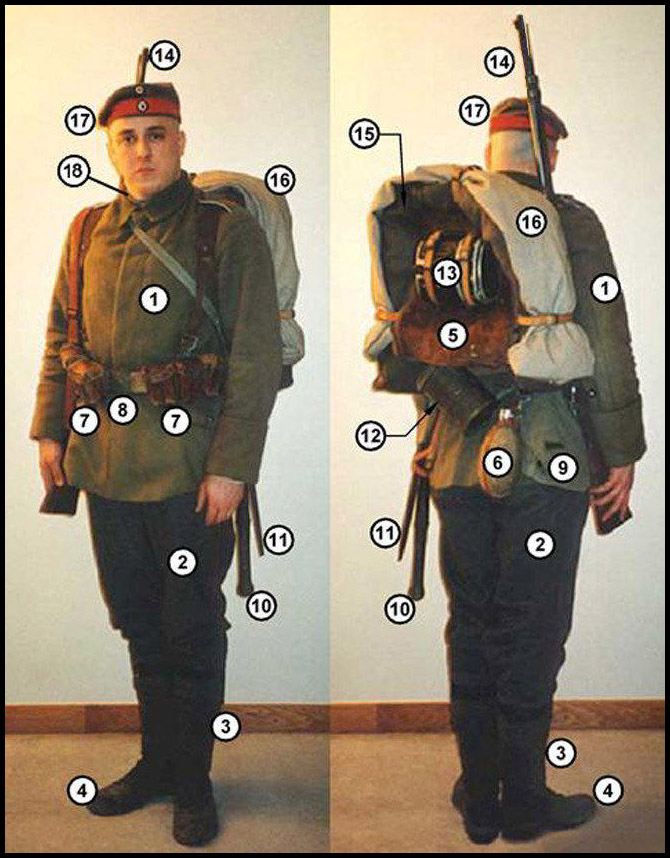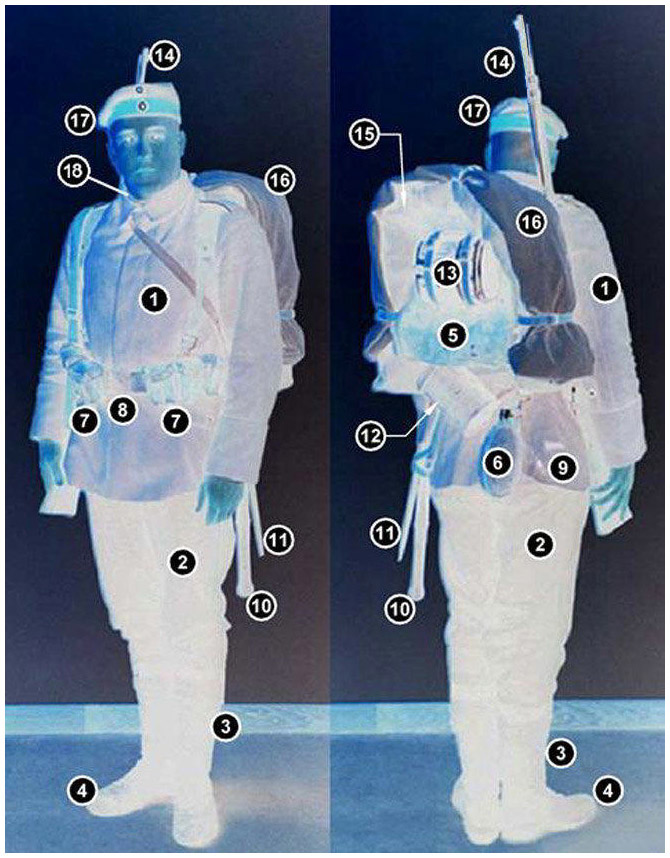Main Menu

IR63's Complete Soldat
The items listed in this section are the minimum kit items with optional items for a complete 1917/18 impression for IR63.
1917-18 Marching Order

- M.1915 "Bluse" (Tunic) The Bluse was made in a new darker Feldgrau (field grey) wool then previous tunics. It had a fall collar faced with a lighter Resedagrün (pea-green) material. The six large front buttons were concealed by a fly, and it had two slanted, flapped side pockets. The shoulder straps were narrower, and detachable; nevertheless, they were often sewn firmly down to the shoulders to prevent snagging. They were piped white for infantry and bore the regimental number or monogram in red chain-stitched embroidery. Members of JR63 may also purchase the M1907/10 Waffenrock or the M1914 Vereinfachte Feldrock.
- M.1907/10 Hosen (trousers) in Steingrau (Stone-grey) cloth with 4mm red wool piping on the outside seam.
- Gamaschen (puttees), (puttees), now made out of any available cloth, German or Allied, of a wide range of drab shades.
- M.1914 Schnurschuhe (ankle boots) in black or brown rough-out leather, laced up with eyelets and hooks. Members of JR63 may also purchase the M1866 Marschstiefel.
- M.1895 Tornister (pack) later into the war was made out of grey/grey-green canvas with leather trim; the pack has an internal frame made of wood. The Tornister accommodated changes of clothes, a work uniform, off-duty footwear, reserve rations, extra ammo, etc. The outer stowage comprised the Mantel (greatcoat) and the Zeltbahn (see item 16).
- M.1915 Feldflasche (canteen) of cloth-covered enameled steel with a cork, hooked to the Brotbeutel.
- M.1909 Patronentaschen (cartridge pouches) in pebbled-finish brown leather. Each of the six pouches, in two sets of three, holds three five-round clips of 7.92x57mm cartridges, giving a total of 90 rounds. The weight is distributed by means of a ring mounted behind each triple pouch, hooking to the front shoulder-strap of the Tornister pack.
- M.1895 Koppel und Koppelschloß (belt and belt buckle) the belt would have been rough out either natural oiled or blackened and the buckle would be the M.1915 grey-painted Prussian steel.
- M.1887 Brotbeutel (breadbag or haversack) made of ochre or grey cloth; it looped to the belt by two buttoned cloth straps and a central metal hook. Two rings on the inner face allowed the attachment of a sling so that it could also be worn slung round the body. The Brotbeutel accommodated rations and eating utensils as well as small personal effects.
- Kleiner Spaten oder Schanzzeug und Schanzzeugtasche (entrenching tool & carrier), looped to the left side of the belt by the M.1898 leather carrier. The carrier would be smooth grain leather either natural oiled or blackened the lower straps of the carrier also secured the bayonet scabbard to the spade handle.
- M.1898/05 Seitengewehr (called the "Butcher" bayonet) The bayonet would have been plain "in the white" steel and the scabbard would have been blued steel.
- M.1917 Lederschutzmaske (gasmask), in waterproof leather with a filter cartridge. Its field-grey painted metal canister was slung on a fabric or papercloth strap.
- M.1910, M.1915 oder M.1917 Kochgeschirr (mess kit) in aluminum or enameled steel, was fixed to the Tornister flap by two brown or blackened Kochgeschirrriemen (messkit straps).
- M.1898 Mauser Gewehr 98 (rifle '98), in 7.92x57mm caliber. For IR63 we can use either the early war configuration with the marking disk on the buttstock and no finger grooves in the forestock, or the later model with the bolt take-down lug in the buttstock and the fingergrooves.
- M.1915 Mantel (greatcoat) in Feldgrau (field grey), the large fall collar faced with as on the Bluse. It fastened with six large uniform buttons, and had two large flapped pockets in the sides, set at a slant. Members of JR63 may also purchase the M.1908 Mantel.
- M.1892 Zeltbahn (tent/shelter-quarter) made of ochre or wartime grey/grey-green colored canvas.
- M.1910 Feldmütze (field cap) in Feldgrau (field grey) cloth, its band and piping in red (for infantry). Two small pressed metal cockades are sewn to the front: on the crown were the national colors of black, white and red, and on the band were the colors of the regiments state of origin (here the black and white of Prussia). After the first year or so of the war, this cap was usually only worn behind the lines. In 1917, a drabber version of the Feldmütze , called the M.1917 Einheitfeldmütze with an "all-arms" Resedagrün (pea-green) band was introduced, but the old style Feldmütze continued in use alongside it, usually with a drab-colored cloth strip fitted over the red band.
- Halsbinde (neck stock) in grey or grey-green cloth, tied around the neck to protect the wool collar from sweat and wear.
- (Not shown) M.1916/17/18 Stahlhelm (steel helmet) The steel helmet employed by the German army in WWI came in three basic models, with the main difference being the configuration of the liner. The M.1916 u. M.1917 used M.1895 Pickelhaube chinstraps with the M16 having a leather band liner while the M17 used a steel band. The M.1918 used a steel band liner practically identical to the M.1917 but with a new two-piece chinstrap with ends that connected under the chin with spring clip.
- M.1873 Troddel (bayonet knot) [Not Shown] is woven in colors to represent the company - for IR63 that will be yellow-white-yellow for 3rd Company.
Work and Training
- Drillich (Drill or Fatigue Uniform) The Germans issued a lightweight uniform specifically for drill or heavy work. This uniform was made from natural, undyed or light-grey cotton linen.
